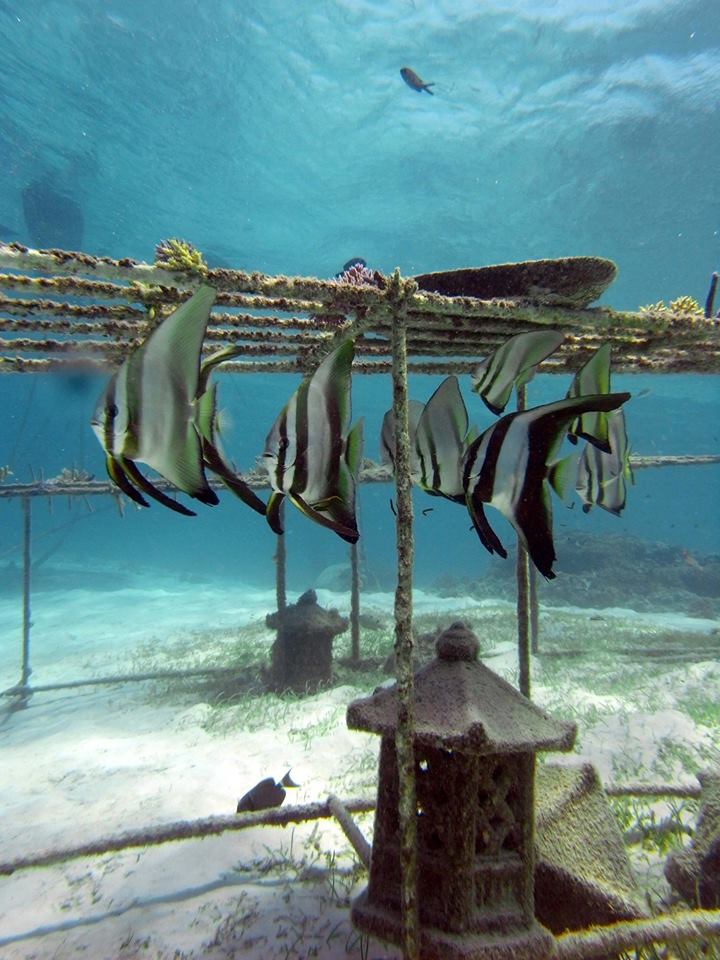The ART-ificial Reef Park is a project to revitalize the dead coral reef in the warm tropical sea off Lombok’s Senggigi Beach. The Official Launch of the Reef is May 24th and I can’t wait to get my snorkel on!
Indonesia’s acclaimed artist Teguh Ostenrik, will “electrify” his metal sculptures with a revolutionary scientific process that turns dissolved minerals in seawater into Biorock, or “seament.”

A collaborative effort of the Lombok Hotel Association (LHA) and Indonesian Marine Affairs and Fisheries (KKP), with support by Indonesian-based Gili Eco Trust, the project with its planned on-going art installations, is being described as “an underwater art gallery” that will eventually extend the length of Senggigi Beach, Lombok’s popular visitor destination. The artist himself calls it an “Art-e-fish-al” reef park, a gentle ocean floor for viewing art while snorkeling and diving amongst marine life.
“I dove that reef for years for its abundance of shrimp and squid and lobster,” said Teguh Ostenrik, the project’s inspiration and founder. “The I hadn’t been for a few years while in Europe and when I came back, the reef was sadly a lifeless desert. This project allows me to have a part in revitalizing the lost coral and to do it through my art.”
Using scrap steel salvaged from various sources around Lombok, Teguh has created two-meter-high sculptures that will be anchored to the reef rubble and connected to a low-voltage electrical current generated from a floating solar panel. “This will cause minerals in the water to form and adhere to the sculpture,” said Delphine Robbe, reef restoration specialist at Gili Eco Trust, a consultant for the project. “Live coral fragments are then transplanted from other reefs and because the Biorock is so similar to natural coral reef material, a new garden grows, often at two to six times the rate of a natural reef.”
She adds, “The electrical current is what attracts the marine life. All those artificial reefs using everything from airplanes to ships to old railroad cars have proven to be a disappointment, rusting away and polluting the sea. Sculptures were used in Mexico’s massive Mesoamerican Reef some years ago as an example, but all they seemed to attract were sponges and algae. The electrification is the key. And it is completely safe for swimmers and marine life.”
The project is hailed as not just eco-friendly, but also something that will support Lombok’s fast-growing visitor industry. As general manager of the Sentosa Resort in Senggigi and chairman of the Lombok Hotel Association, Stephane Servin knows what the death of a reef means.
“We can’t pick up and move our hotels when the reef dies,” he said, “so obviously it’s plain common sense to do whatever’s possible to preserve and protect the natural features that brought visitors here to begin with. And if possible, repair and recreate them using Biorock science and at the same time we bring back the livelihoods for so many who relied on a healthy reef.”
Delphine adds: “Indonesia has the world’s highest coral reef biodiversity and only six percent is still in a pristine state. The reasons for the loss are many, from fishing with dynamite to global warming. So it’s a matter of corporate responsibility to do something about that when provided the opportunity. When a natural forest or ocean or river provides for you and then threatened, you better do everything you can to give back.”
Teguh, the son of a policeman born in 1950 in Jakarta and one of the few Indonesian artists to exhibit widely in galleries from the Netherlands to Japan, made his first visit to Lombok in 1984 after living 10 years in Germany. At that time, Senggigi Beach was famous as a habitat for shrimp and squid. Its disappearance, he said, contributed to his use of scrap metal as an expression of his belief in recycling.
Teguh said the first of his art pieces will be positioned off the beach from de Quake restaurant, located approximately midway along Senggigi Beach. In order for the project to grow as it should and maintain a desired aesthetic as any other quality gallery, Teguh is looking for a qualified curator to help decide which pieces complement the park, from both local and international artists.
Interest also has been shown by sponsors, including mining companies to donate the steel to be used in the sculptures, along with hospitality groups to help pay for the art. Stephane Servin says interested individuals or commercial enterprises should contact the Lombok Hotel Association. “Naturally, we are completely devoted to giving something back and grateful for those interested in this worthy initiative.”
Biorock reef restoration projects exist throughout the world, from the Caribbean to the Indian Ocean, from Panama to Papua New Guinea to Thailand and Indonesia. Two of the largest projects are in Indonesia at Pemuteran with the Karang Lestari and the Gili Islands with the Gili Eco Trust.








